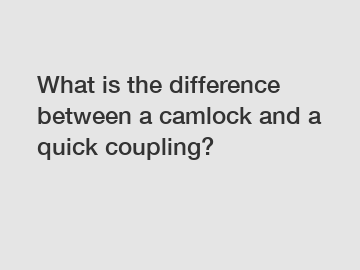What is the difference between a camlock and a quick coupling?
What is the Difference between a Camlock and a Quick Coupling?
In various industries, the use of couplings is essential for connecting hoses and pipes to facilitate efficient liquid or gas transfer. Two popular types of couplings used for this purpose are camlocks and quick couplings. While they may seem similar at first glance, there are distinct differences between these two types of couplings. In this article, we will delve into the dissimilarities and understand which type of coupling is best suited for different applications.
Camlocks, also known as cam and groove couplings, are widely used for connecting hoses in various industries, including agriculture, manufacturing, and oil and gas. These couplings feature male and female parts that are locked together with a handle or lever. The male part consists of a grooved adaptor, while the female part consists of a cam or lever arm that engages with the grooves. This mechanism ensures a secure and leak-proof connection.

Quick couplings, on the other hand, are designed for rapid connection and disconnection without the use of tools. They are commonly used in applications where frequent connections and disconnections are required, such as hydraulic systems and pneumatic tools. Quick couplings typically consist of a male and female part, with one side having a valve or a shut-off mechanism to control the flow of fluid. These couplings often rely on push-to-connect or twist-to-connect mechanisms for quick and easy operation.
3. Structural Differences.
While both camlocks and quick couplings serve the purpose of connecting hoses or pipes, they have structural differences that set them apart. Camlocks typically have a larger size and heavier construction compared to quick couplings, making them suitable for high-pressure applications. Quick couplings, on the other hand, are more compact and lightweight, making them ideal for applications where space and weight are constraints.
4. Fluid Compatibility.
Another significant difference between camlocks and quick couplings lies in their fluid compatibility. Camlocks are versatile and can handle a wide range of fluids, including water, chemicals, and petroleum-based products. Quick couplings, on the other hand, are designed for specific fluids, such as hydraulic oils, air, and gases. Using quick couplings with incompatible fluids can lead to leaks and potential damage to the couplings.
5. Benefits and Drawbacks.
Both camlocks and quick couplings offer distinct benefits and drawbacks. Camlocks provide a secure and leak-proof connection, making them suitable for applications with high-pressure fluids. They are also easy to operate and can withstand rough handling. However, they require a bit more time for connection compared to quick couplings. Quick couplings, on the other hand, provide rapid connection and disconnection, saving time and effort. However, they may not offer the same level of security and leak-proofing as camlocks.
In conclusion, while camlocks and quick couplings serve a similar purpose of connecting hoses and pipes, their differences lie in their structural design, fluid compatibility, and application suitability. It is essential to consider the specific requirements of the application to determine which coupling type is the most appropriate choice.
If you have any further questions or need assistance in selecting the right coupling for your application, please feel free to contact us. We are here to help you make an informed decision and ensure efficient fluid transfer.
For more information, please visit Cam Locking Quick Connector, 3 Piece Ball Valve Wholesale, 3 Way Ball Valve Supplier.
183
0
0


Comments
All Comments (0)